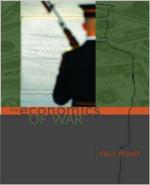|
This section contains 1,642 words (approx. 6 pages at 300 words per page) |

|
Economic Reckoning.
The relatively prosperous first years of the century came to a halt in 1907 when drains on the money supply revealed a weak national financial infrastructure of banking and credit and precipitated an economic crisis that lasted nearly a year. The money supply was low because of the lack of cash flow from farmers due to a late season and was further drained by overspeculation in copper, money being diverted to the Russo-Japanese War of 1905, the rebuilding of San Francisco after the 1906 earthquake (exacerbated by huge insurance payouts), and the nationwide railroad expansion program. After the stock market fell drastically in March, prices soared, wages decreased, unemployment rose, and many businesses, including banks, failed.
The First Bank Failure.
The first bank in trouble was Mercantile National, whose owner, F. Augustus Heinze, was a primary figure in the copper overspeculation. Since there was...
|
This section contains 1,642 words (approx. 6 pages at 300 words per page) |

|




